Anime Anatomy Drawing – Create the Body Base of Your Anime
Anime anatomy is quite similar to that of normal human anatomy; however, the difference comes in when we either emphasize or minimize features due to animation style. Anime is a broad genre; therefore, the anime body anatomy can be done in various ways. Understanding the basics of human anatomy is essential for anime body anatomy as it will give you better insight into proportions and body styling within your own anime drawings.
Table of Contents
An Easy Guide to Drawing Anime Anatomy
Anime anatomy is really simple once you break down the process of human anatomy and how the body is divided into its different segments. Having a knowledge of human anatomy, you will find that the process of creating different anime styles becomes much easier.
Necessary Materials
This tutorial is done with a digital device; however, you can apply all these concepts to traditional art mediums. We will be breaking down the simple concepts of anime anatomy, so we will only need some basic materials such as a pencil, and pen. We will want to have a ruler for measurements, as well as a sharpener and an eraser for any mistakes that might need fixing. All materials can be found through the links below:
- Pencils
- Ballpoint Pen
- Ruler
- Sharpener
- Eraser
- Good Paper (200 g/m – 250 g/m recommended)
A Guide on How to Draw Anime Anatomy
In this tutorial, we will look at some basic human anatomy concepts that are important for understanding the proportions and scale of the body. We will look at both female and male human anatomy and then how we can’t change and emphasize features to resemble a more cartoonish and anime-styled character design. Now that we know what to expect, let us go through some basic anime anatomy drawing concepts.
Understanding Human Proportions
When drawing anime characters they often exaggerate the human anatomy, so it is important to know the proportions of human anatomy as a body base of your anime. This will help you to form anime characters more adequately, providing you with an understanding of the segments of different body parts.

The Male Figure
With male figures and female figures, we will find that the body is broken up into eight equal segments. We can establish these segments with a grid that is divided into eight equal segments, with a single vertical line divided into two halves.
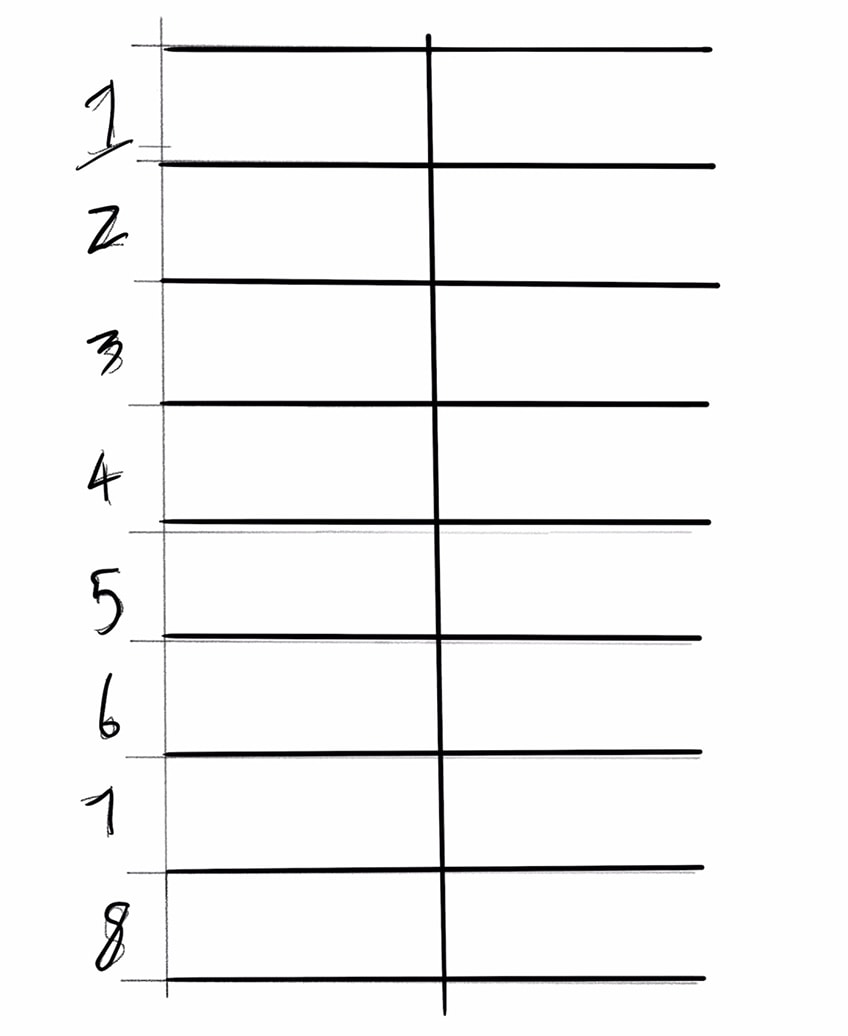
From here we can lightly erase this grid, this will help us to draw over it, whilst still using it to guide our drawing process.

In the first segment is where the head will be drawn of the male figure. We want to make sure that we keep the body parts proportional and symmetrical along the vertical line.

The shoulders will form from the trapezius muscles, which extend into the second segment. Here the chest will overlap into the third segment, flowing into the stomach and abdominal area, where the hips will form in the fourth segment.

We will find that the crotch or pubic bone determines the center or halfway point of the figure. The bisects will form alongside the ribs and stomach, where the forearms will flow into the fourth segment next to the hips.

the hands will form in the fifth segment, placed alongside the thighs of the figure. With male structures we can emphasize the muscles slightly more, giving a more masculine and broad stature to the figure.

The knees will form in the sixth segment near the bottom section, which then will flow into the shins and feet, between segments seven and eight.
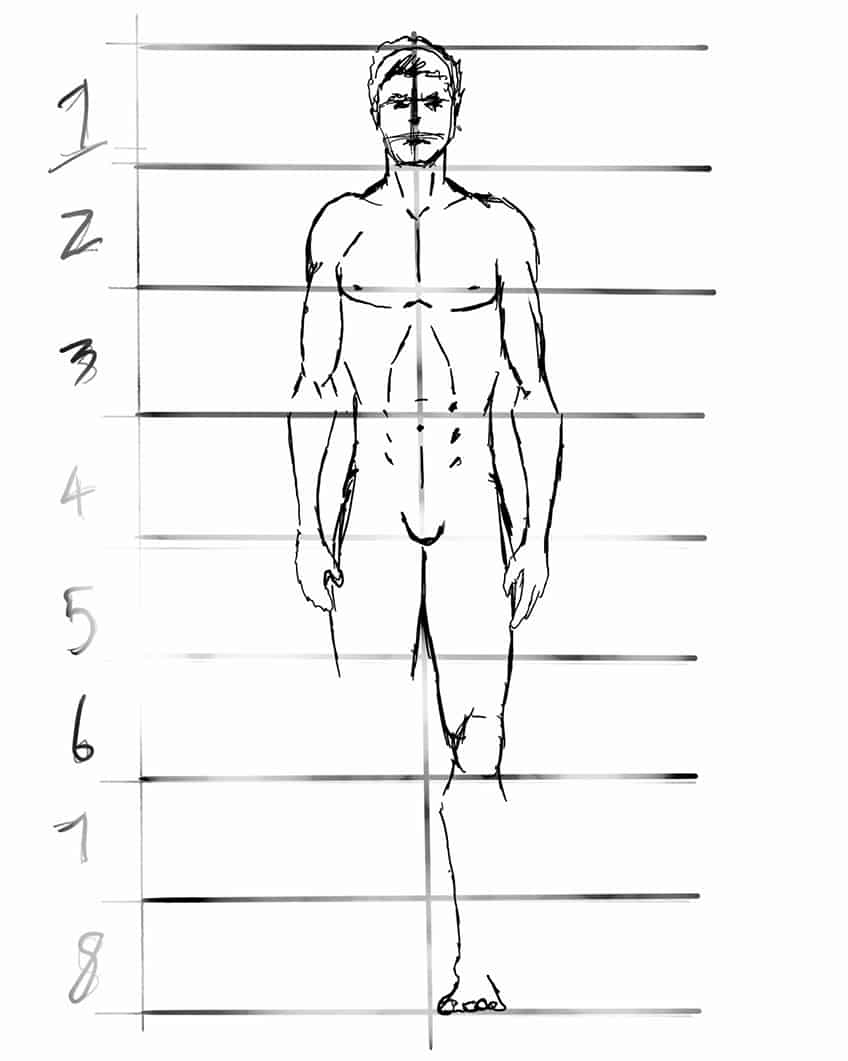
The feet will be drawn at the very bottom of the eighth and last segment, where the ankles will also be drawn. This is the basic scale of the male figure and how to draw the anatomical proportions correctly within their corresponding segments.

The Female Figure
We can do the same for the female figure, where we establish a grid with eight evenly divided segments. We can also draw a vertical line through the center of the segments to divide them into two halves.
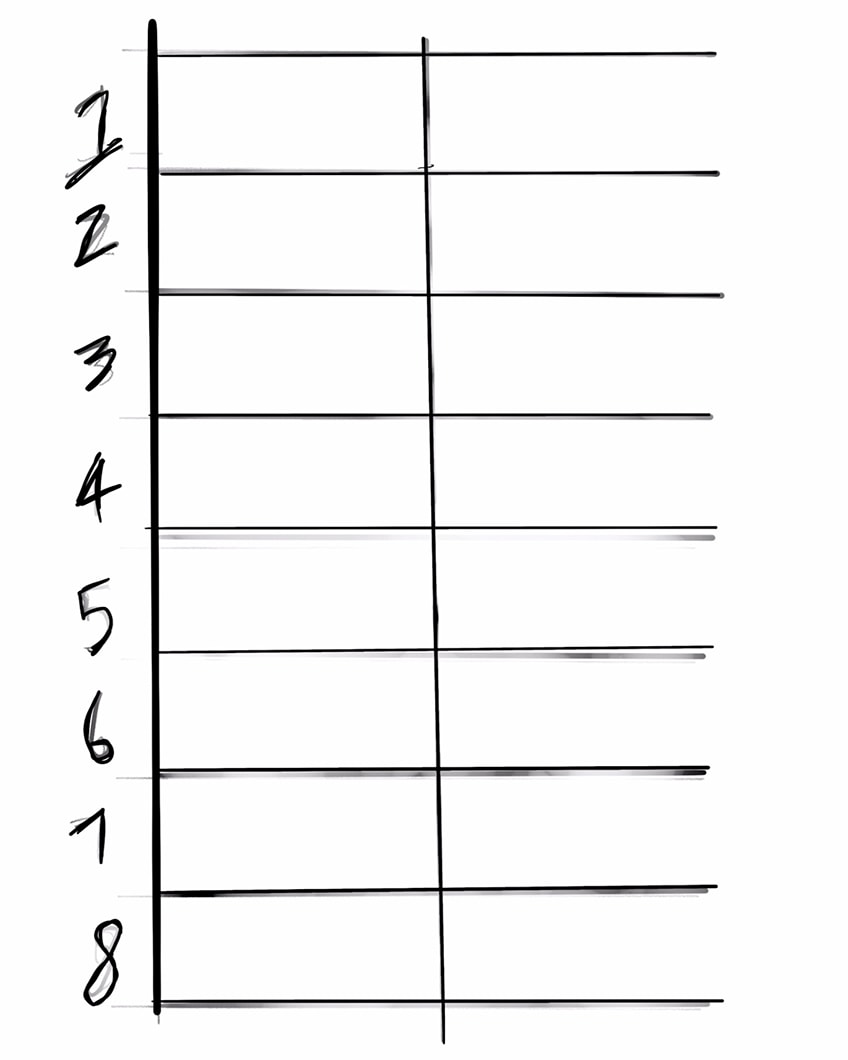
The formation of the female stature is the same, where the head and neck flowing into the shoulders and breasts, from the first to the second segment. However, the breast will start to flow into the third segment.
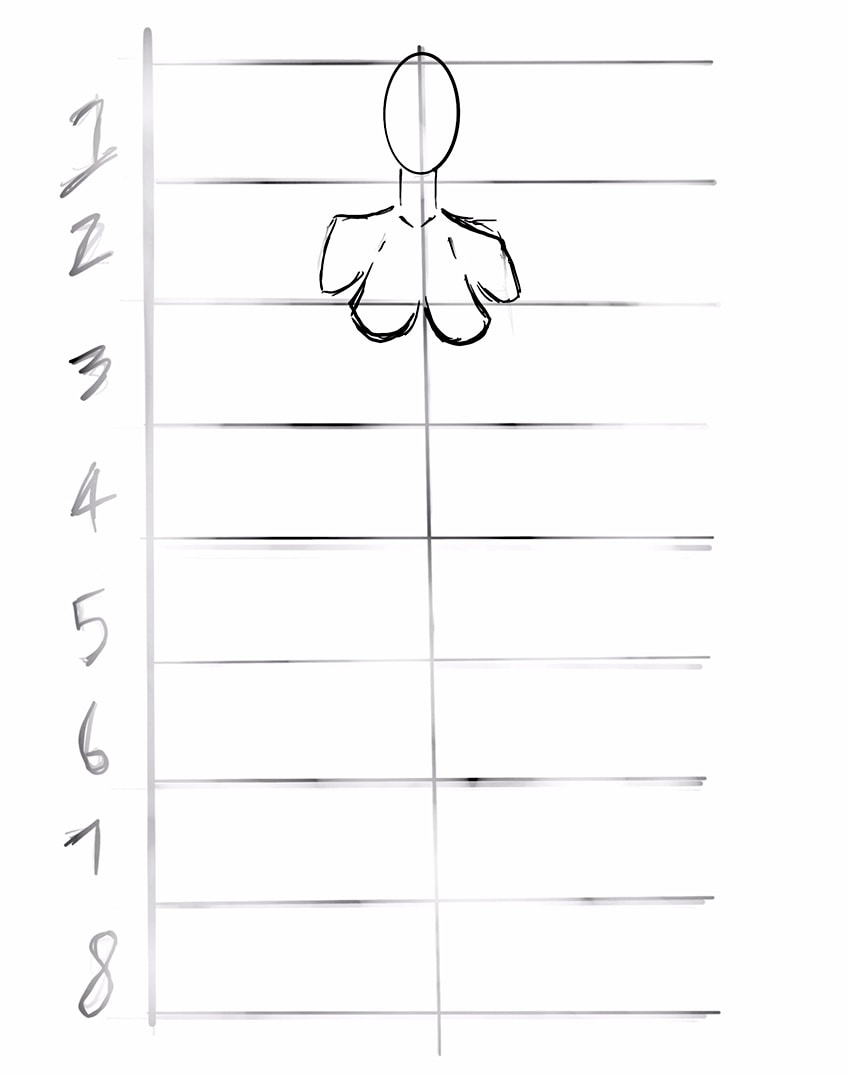
We will find that the hips of the female figure will form within the fourth segment, however, we can give them more width to suggest a more feminine structure.

The pubic bone will also be drawn at the fourth line between the fourth and fifth segments as the halfway point between the head and the feet. The arms will form alongside the figure, with the hands meeting at the hips in the fifth segment.

The knees will start to form in the sixth segment, which will be the dividing point between the bottom and the top of the knees. With the female structure, we can be more subtle with the muscles to suggest a more feminine physique.
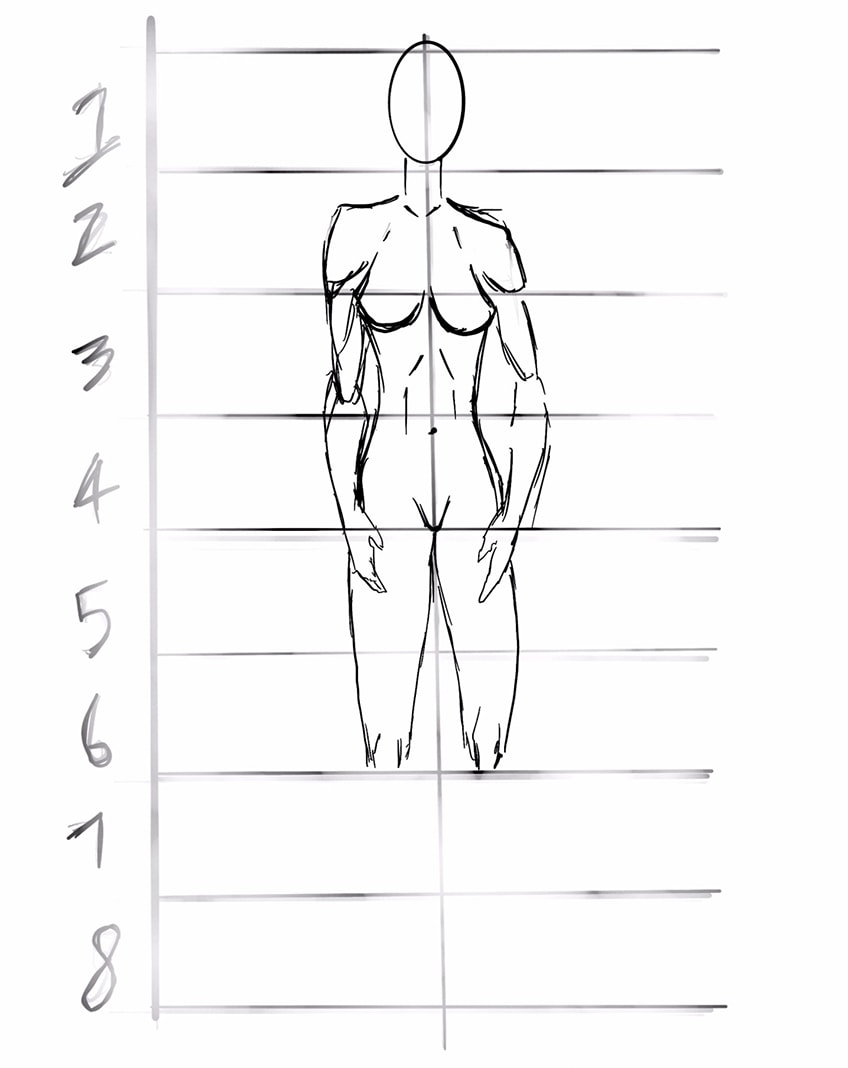
The legs will continue into the seventh and eighth segments, where the feet will be drawn in the eighth and last segments. The ankles will also be drawn within this segment.
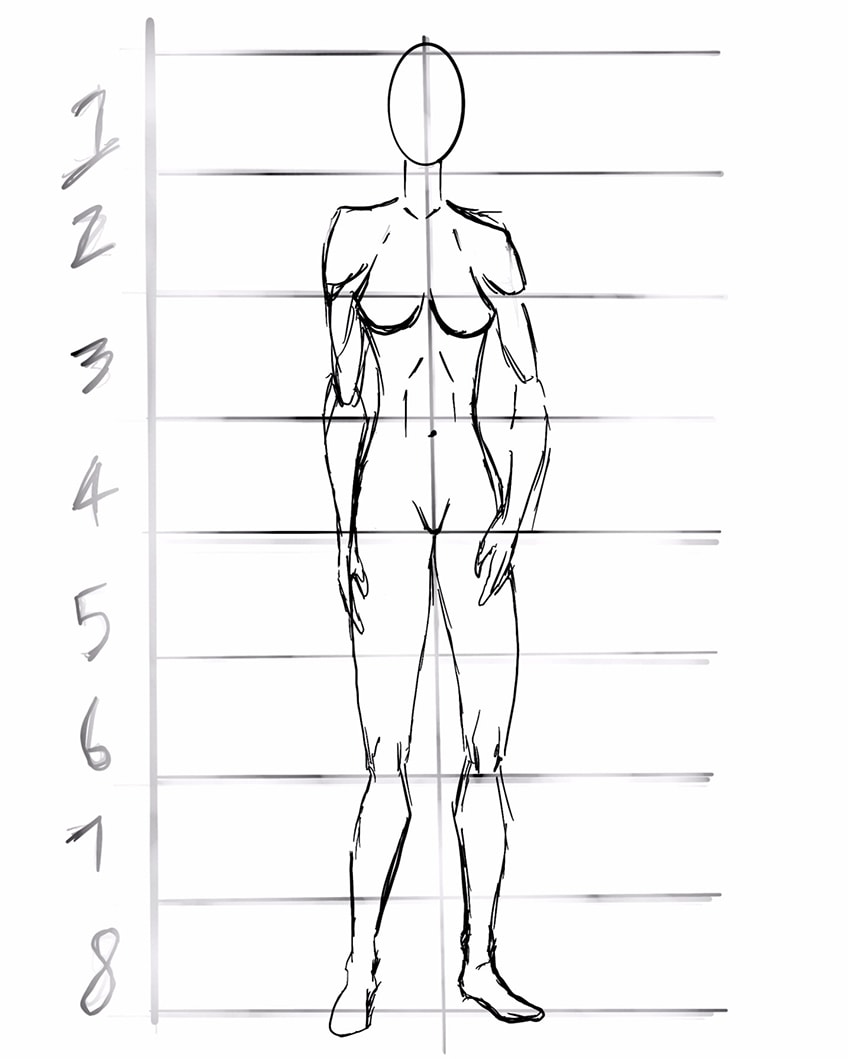
The hands will be placed within the fifth segment of the anatomy drawing, we want to make sure that all these features are placed in their correct corresponding segments. The process of drawing the female structure is the same as that of the male structure.

Human Proportions Comparison
We will find that both male and female structures follow the same segmentation process. This places their features in the same sequence of scale according to their respective heights.

However, we will find that different body shapes are always going to have subtle differences from one another. This segmentation process is a matter of creating a reference to work from.

When we want to draw male and female figures together to determine height and scale differences, we follow the same method. However, this time we can make the segments slightly larger for the male and slightly smaller for the female, and vice versa if we want the male figure to be smaller.
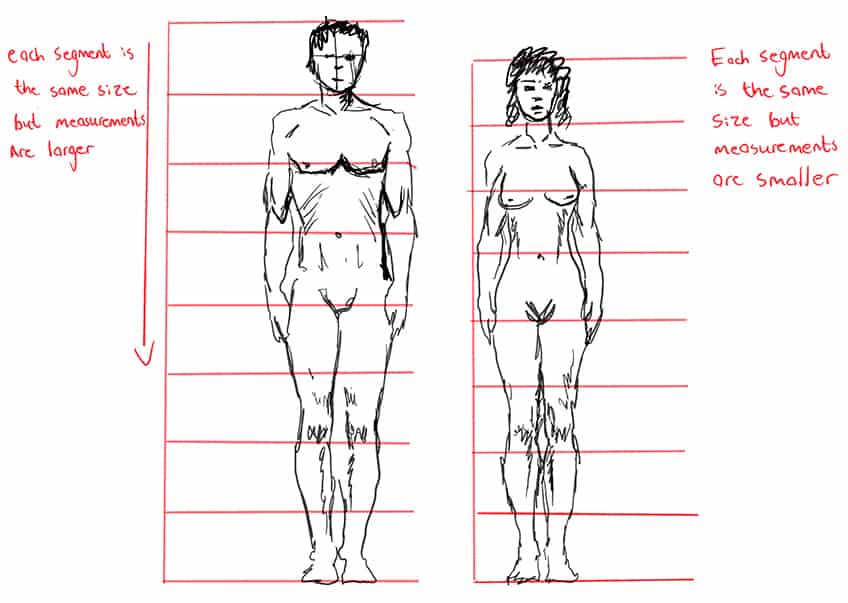
Emphasizing Human Features for an Anime Style
As we have now worked out human proportions, we will find that they serve as a really good body base for your anime drawings. This is because anime is often just an exaggeration of normal human anatomy, this means that if we have the knowledge of basic human anatomy, we can exaggerate these features to create more anime body anatomy drawings.

Exaggerating the Female Body to Create Female Anatomy Anime
The process of drawing female anatomy anime can be done by using the human anatomy drawing as a reference. This time we can start to define the features a little more, such as broadening the shoulders or making the bosom more robust.

This can be applied to all features, where the muscles of the figure become more prominent and exaggerated. This establishes a more unrealistic and heroic figure that is common within anime anatomy drawing.
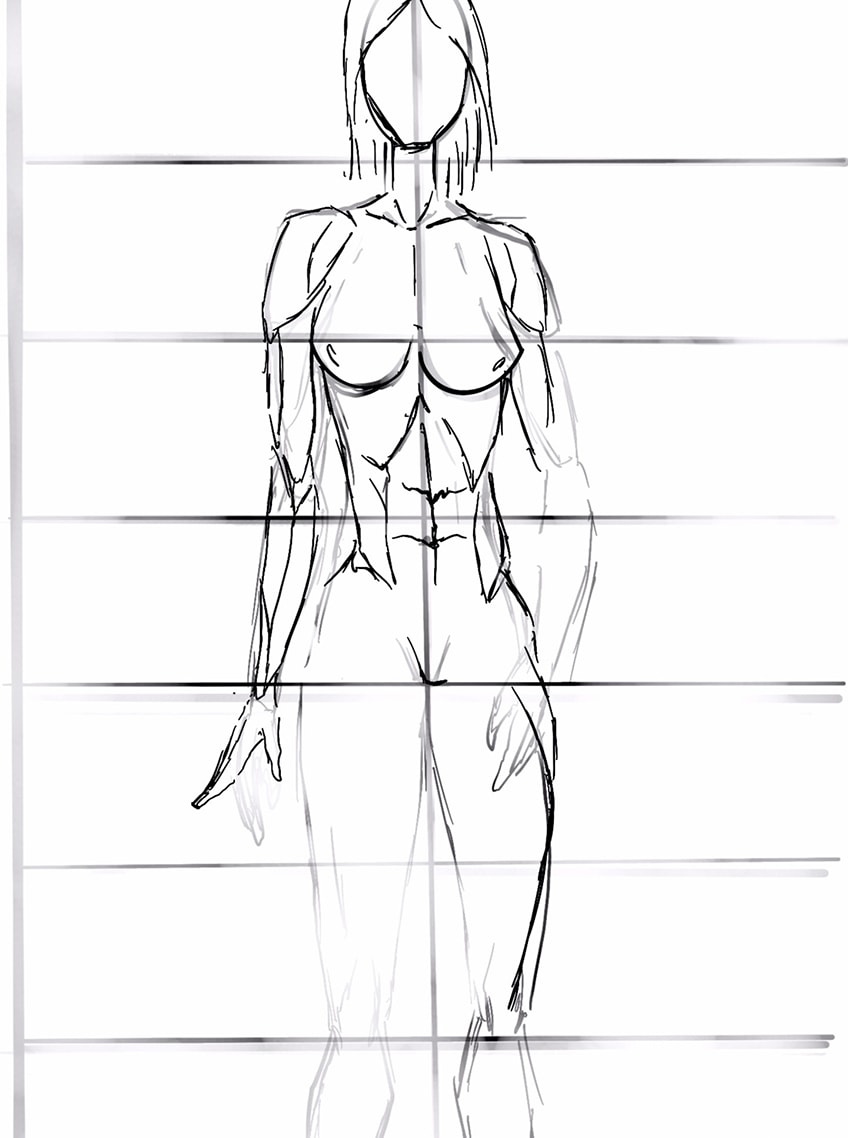
The same can be done within the hips, where they are more curved and broader. As you progress with a female anime anatomy drawing, you can simply emphasize each feature as you go.

This is true for all the muscles of the character, as they often seem prominent through clothed characters as well. Anime characters often fill out their clothing, which means we want to emphasize the muscles.

We can also give more harsh edging to the character, which means we can make their structure slightly more geometric in form. This provides an extract cartoonish element to the anime body anatomy.

By giving more harsh edging or sharper outlines to the character we start to animate the character further. This is also a matter of stylistic preference, according to how you would like to stylize with your female anime anatomy drawing.

Exaggerating the Male Body to Create Male Anatomy Anime
The same process of exaggerating features can be applied to anime male anatomy. Again, anime is simply a more unrealistic and exaggerated version of human features. However, we still want to maintain correct proportions, which is why human anatomy should be the body base of your anime anatomy drawings.

This also allows us to play around with positioning and posing, using the segments as a. Basic guideline for building an anime male anatomy drawing.
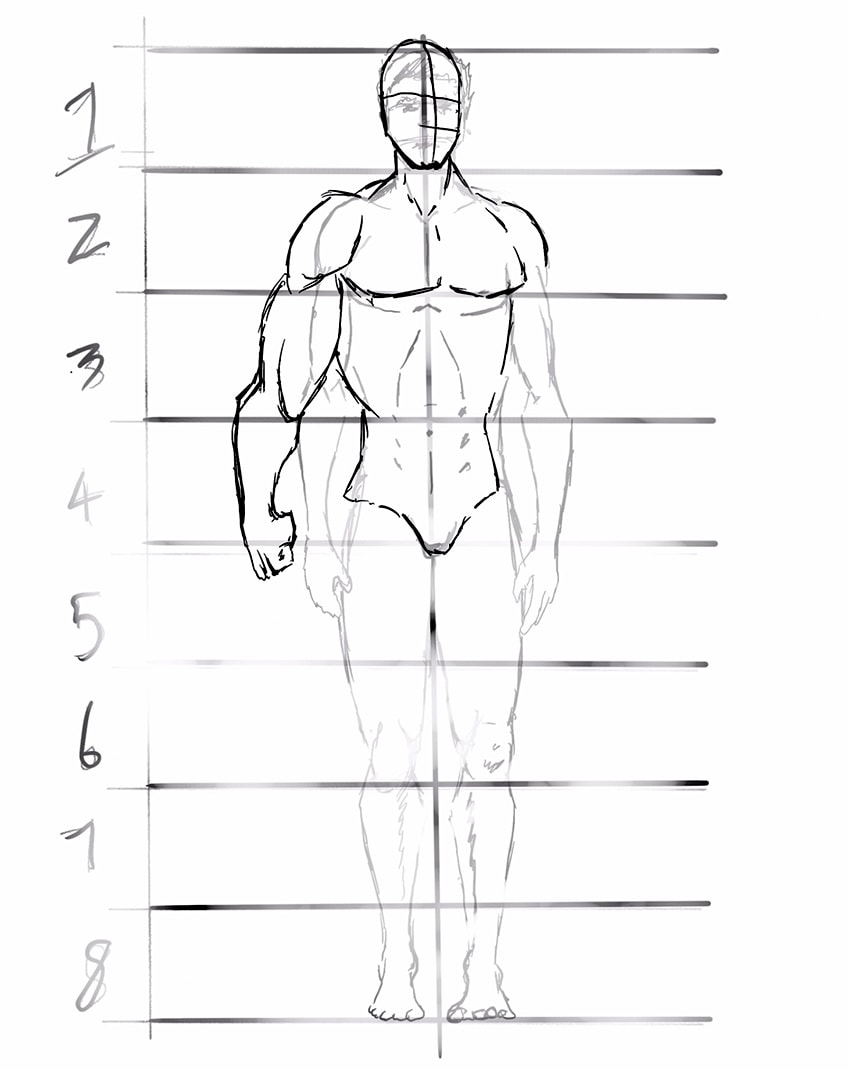
The muscular aspects of the character become more prominent to suggest a more heroic and competent stature in the anime character design. This means all muscle groups become slightly larger.

This applies to all muscle groups, however, the human anatomy provides a good anime anatomy reference, because it keeps the composition of the character proportionally correct.
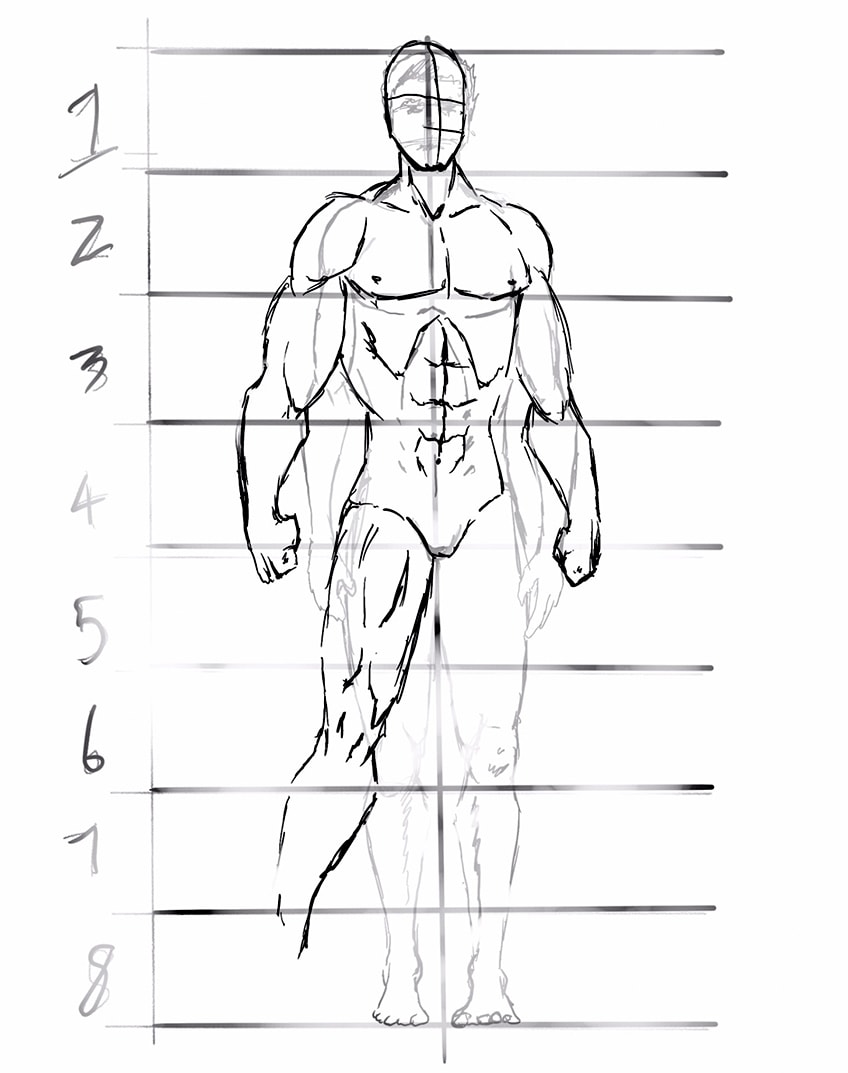
This means that we can play around with how much we would like to exaggerate our anime anatomy drawings and their muscle stature. As long as we stick to the eight segments, the anime anatomy drawing will seem proportionally correct.
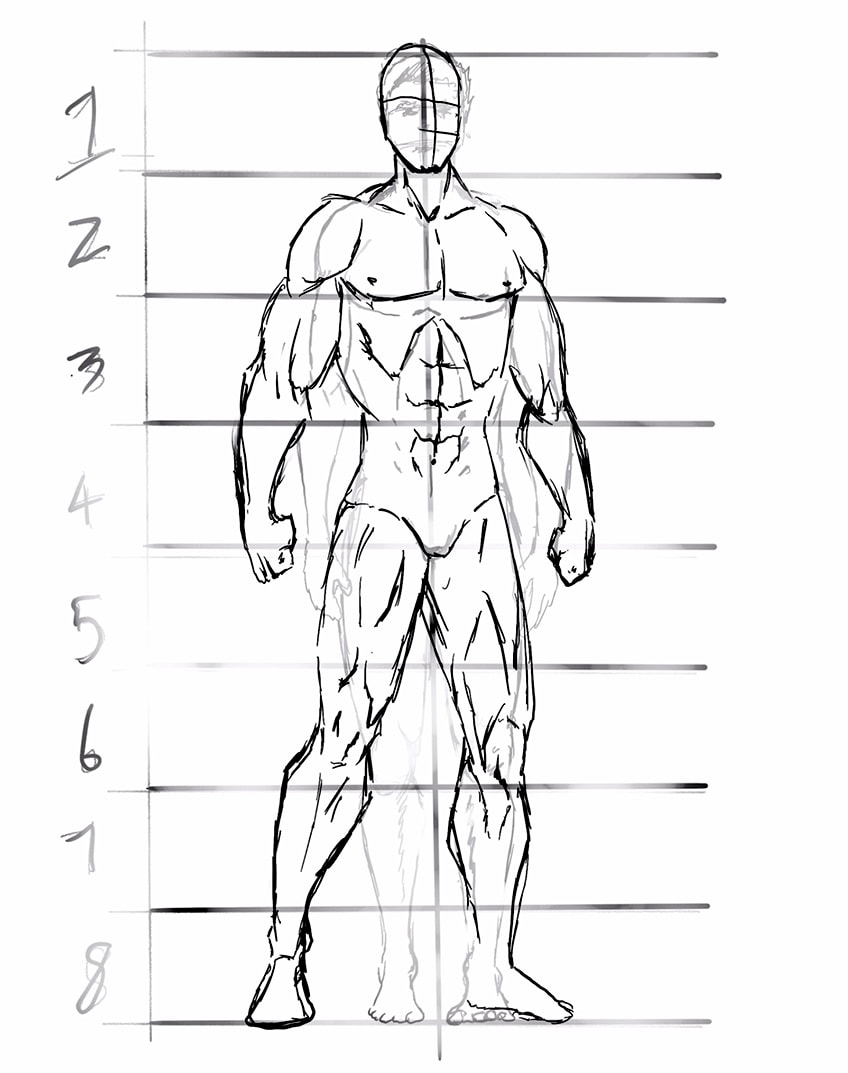
Basic human anatomy provides a really good anime anatomy reference because anime characters still look proportionally correct. Having a reference point to work from will make the drawing process much simpler.

Then, once we start to contextualize the body with faces with anime features, the body starts to make more sense as an exaggerated structure that fits within the genre of anime.

This is the basic process of anime anatomy drawing and how to build up a character’s physique from the ground up. Using human anatomy and the even segmentation of different body parts is a helpful way to draw anime characters in different styles.
It’s all a matter of understanding the basic anatomy of both male and female figures. From there, your stylistic choices come into play, whether you want your characters to be subtle or more exaggerated in their features. Once you understand the basic anatomy of human proportions, you then can experiment with character design.

Tips to Remember
- Use the eight segments. The eight evenly-segmented sections of the body are the most accurate way to draw proportions correctly for anime anatomy drawing.
- Human anatomy is simply an anime anatomy reference. This means we can change the scale and proportions as we choose.
- Use sharp and harsh lines for more animated aesthetics. Giving the anime drawing bold and sharper lines gives it a more cartoonish aesthetic.
- Experiment with character designs. Once you know the proportions, play around with different body types for both male and female anime anatomy.
Anime anatomy is far from normal human anatomy when it comes to proportions. This is why human anatomy provides a good body base for your anime drawings and can be a good anime anatomy reference to work with. Once you understand the proportions, you then can play around with creating different anime character designs!
Take a look at our how to draw anime anatomy webstory here!
Frequently Asked Questions
Do You Need to Know Human Anatomy for Anime?
Anime is an art genre that has various art styles, which means that there is no singular way to draw anime characters. However, when you want to explore female anatomy in anime and how this compares to anime male anatomy, understanding human anatomy can be a good foundation. This is particularly true when you want to create a specific styled anime where there is consistency in character design. Human anatomy provides a good framework to work from, and can then become a point of reference for exploiting distortion in anatomy to suit your particular anime style.
How Do You Draw Anime Proportions?
Anime proportions are drawn in various ways; however, the anatomy of human bodies is often broken up into eight segments. The pubic area becomes the halfway point, which breaks up the body into two main parts. This is the same for anime characters, that being said, anime characters tend to be more exaggerated in their features which gives them their unique anime quality. Anime proportions can be drawn normally with human proportions as a guide. Playing around with emphasizing features for more length and shape in various features is just a stylistic choice. Once you understand the eight segmentations within the body and how this divides the body into two main sections, you will find that the drawing process of anime characters follows the same process.
Matthew Matthysen is an educated multidisciplinary artist and illustrator. He successfully completed his art degree at the University of Witwatersrand in South Africa, majoring in art history and contemporary drawing. The focus of his thesis was to explore the philosophical implications of the macro and micro-universe on the human experience. Matthew uses diverse media, such as written and hands-on components, to explore various approaches that are on the border between philosophy and science.
Matthew organized various exhibitions before and during his years as a student and is still passionate about doing so today. He currently works as a freelance artist and writer in various fields. He also has a permanent position at a renowned online gallery (ArtGazette) where he produces various works on commission. As a freelance artist, he creates several series and successfully sells them to galleries and collectors. He loves to use his work and skills in various fields of interest.
Matthew has been creating drawing and painting tutorials since the relaunch in 2020. Through his involvement with artincontext.org, he has been able to deepen his knowledge of various painting mediums. For example, watercolor techniques, calligraphy and lately digital drawing, which is becoming more and more popular.
Learn more about Matthew Matthysen and the Art in Context Team.
Cite this Article
Matthew, Matthysen, “Anime Anatomy Drawing – Create the Body Base of Your Anime.” Art in Context. February 6, 2023. URL: https://artincontext.org/anime-anatomy-drawing/
Matthysen, M. (2023, 6 February). Anime Anatomy Drawing – Create the Body Base of Your Anime. Art in Context. https://artincontext.org/anime-anatomy-drawing/
Matthysen, Matthew. “Anime Anatomy Drawing – Create the Body Base of Your Anime.” Art in Context, February 6, 2023. https://artincontext.org/anime-anatomy-drawing/.




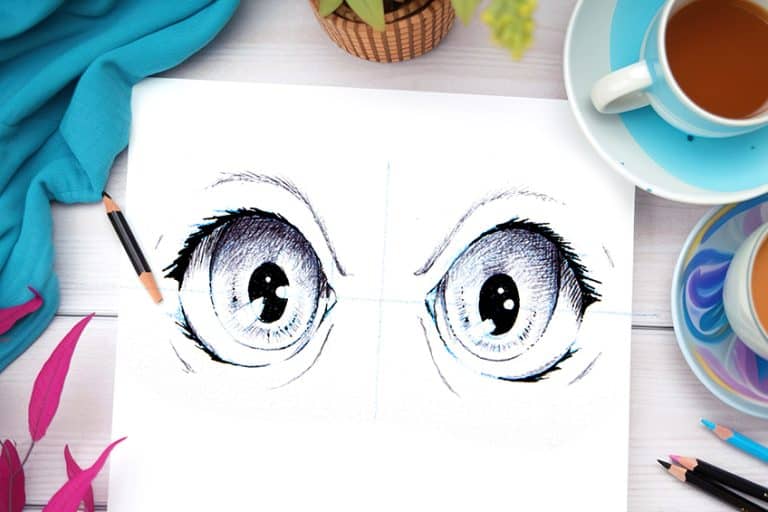

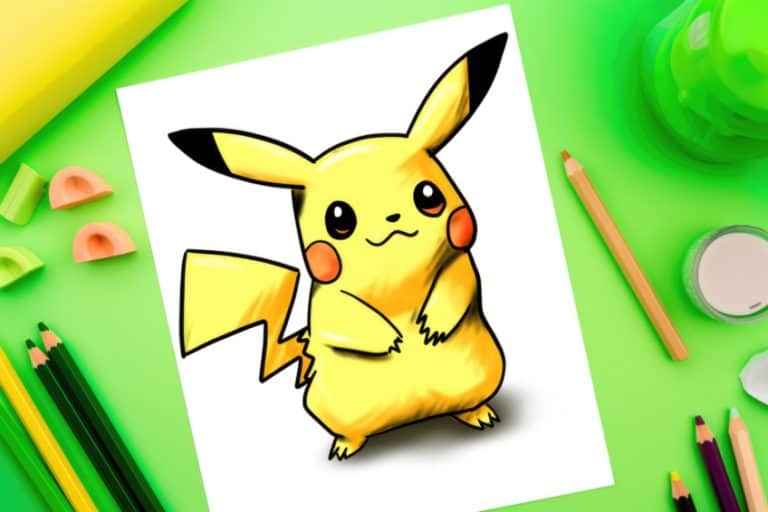
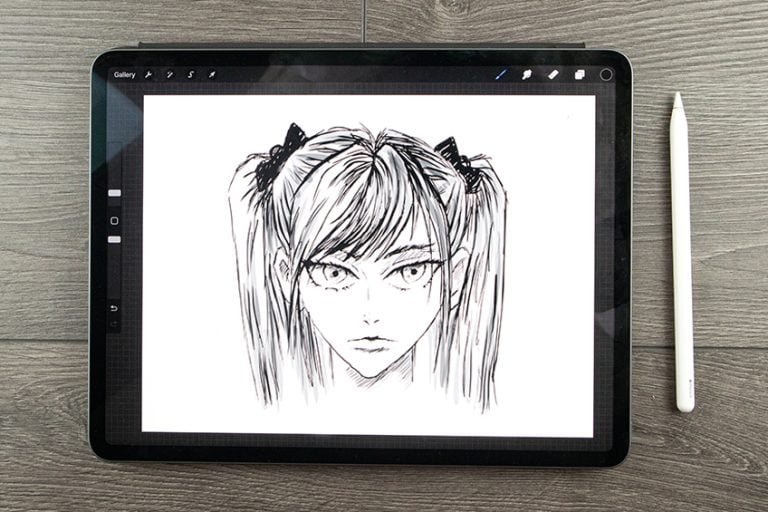

those are really great and simple to understand!